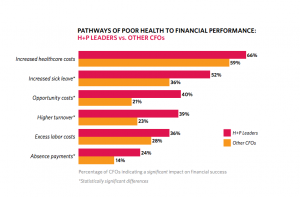Since eight out of 10 Chief Financial Officers are involved in health care decisions, according to IBI (Integrated Benefits Institute)’s 2011 CFO survey brief, it’s key to know their point of view. (This post is based on the brief. Not being a member, I don’t have access to the full report.)
The IBI survey found that 30 percent of their CFO respondents rated health as a very important contributor to workforce productivity. Investing in health still lags behind more traditional productivity investments, such as retention campaigns, skills training and proper staffing levels. (It would be interesting to analyze the data to see whether there’s any correlation between those CFOs who are involved in health care decisions and those who are more likely to rate health as a very important contributor.)
What is critical decision-making information?
Because this survey is meant to equip benefits professionals with useful data, IBI asked CFOs to share what information is critical to their decision-making about health investments. They said that their company’s claims data is the most critical, followed by the cost of providing medical and other benefits.
 Benefits pros will be heartened to hear that CFOs recognize the value of their recommendations as well as employees’. They look to employee survey results and pilots to guide their thinking.
Benefits pros will be heartened to hear that CFOs recognize the value of their recommendations as well as employees’. They look to employee survey results and pilots to guide their thinking.
IBI also sought to identify health and productivity leaders. They determined that only three in 10 respondents qualified as an H+P (human-capital productivity) leader — leaders who were identified as being keenly committed to the importance of workforce health through their responses to three questions. In the brief about the survey, IBI commented:
H+P Leaders were more than twice as likely as other CFOs to believe that improving employee health is very important to workforce productivity. These H+P Leaders also were almost twice as likely to see the significant impact of poor health on financial performance than other CFOs, and were more than twice as likely to consider internal company information very credible.”
All of this is important, as it means H+P leaders are more likely to make sustained investments in employee health and to personally support a healthy workplace. However, there’s an important missing ingredient: does a company with an H+P leader see stronger company performance than one without?
That’s CFO-attention-grabbing information.
You can find the brief on IBI’s 2011 CFO surveyhere.
Fran Melmed will be speaking on “The Second-Generation Workplace Wellness Program” at the TLNT Transform conference in Austin, TX Feb. 26-28, 2012. Click here for more information on attending this event.
This was originally published on Fran Melmed’s free-range communication blog.
